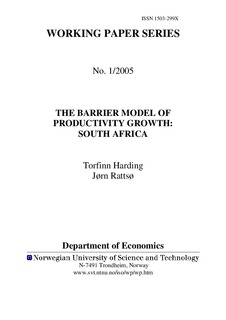| dc.contributor.author | Harding, Torfinn | nb_NO |
| dc.contributor.author | Rattsø, Jørn | nb_NO |
| dc.date.accessioned | 2014-12-19T14:31:50Z | |
| dc.date.available | 2014-12-19T14:31:50Z | |
| dc.date.created | 2006-10-03 | nb_NO |
| dc.date.issued | 2005 | nb_NO |
| dc.identifier | 126074 | nb_NO |
| dc.identifier.uri | http://hdl.handle.net/11250/267111 | |
| dc.description.abstract | The barrier model of productivity growth suggests that individual country productivity is related to the world technology frontier disturbed by national barriers. We offer a country study of the barrier model exploiting the dramatic changes in the linkages to the world economy in South Africa. The productivity growth in the manufacturing sector panel for 1970-2003 covers a period of political and economic turbulence and international sanctions. The econometric analysis uses tariffs as measure of barrier and fixed effects estimation to concentrate inference to time series properties. The model shows how productivity growth can be understood as a combination of world frontier growth and the tariff barrier to international spillovers. The estimates establish a long run relationship where domestic productivity follows the world frontier and with change of the barrier affecting transitional growth. | nb_NO |
| dc.language | eng | nb_NO |
| dc.publisher | Institutt for samfunnsøkonomi | nb_NO |
| dc.relation.ispartofseries | Working Paper Series, 1503-299X; 2005:1 | nb_NO |
| dc.title | The Barrier Model of Productivity Growth: South Africa. | nb_NO |
| dc.type | Research report | nb_NO |
| dc.contributor.department | Norges teknisk-naturvitenskapelige universitet, Fakultet for samfunnsvitenskap og teknologiledelse, Institutt for samfunnsøkonomi | nb_NO |
